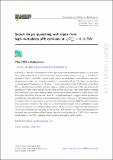Search for jet quenching with dijets from high-multiplicity pPb collisions at √s NN = 8.16 TeV
Author(s)
Chekhovsky, V.; Hayrapetyan, A.; Makarenko, V.; Tumasyan, A.; Adam, W.; Andrejkovic, J. W.; Benato, L.; Bergauer, T.; Damanakis, K.; Dragicevic, M.; Giordano, C.; Hussain, P. S.; Jeitler, M.; Krammer, N.; Li, A.; Liko, D.; Mikulec, I.; Schieck, J.; ... Show more Show less
Download13130_2025_Article_26694.pdf (1.383Mb)
Publisher with Creative Commons License
Publisher with Creative Commons License
Creative Commons Attribution
Terms of use
Metadata
Show full item recordAbstract
The first measurement of the dijet transverse momentum balance xj in proton-lead (pPb) collisions at a nucleon-nucleon center-of-mass energy of $$\sqrt{{s}_{\text{NN}}}$$ = 8.16 TeV is presented. The xj observable, defined as the ratio of the subleading over leading jet transverse momentum in a dijet pair, is used to search for jet quenching effects. The data, corresponding to an integrated luminosity of 174.6 nb−1, were collected with the CMS detector in 2016. The xj distributions and their average values are studied as functions of the charged-particle multiplicity of the events and for various dijet rapidity selections. The latter enables probing hard scattering of partons carrying distinct nucleon momentum fractions x in the proton- and lead-going directions. The former, aided by the high-multiplicity triggers, allows probing for potential jet quenching effects in high-multiplicity events (with up to 400 charged particles), for which collective phenomena consistent with quark-gluon plasma (QGP) droplet formation were previously observed. The ratios of xj distributions for high- to low-multiplicity events are used to quantify the possible medium effects. These ratios are consistent with simulations of the hard-scattering process that do not include QGP production. These measurements set an upper limit on medium-induced energy loss of the subleading jet of 1.26% of its transverse momentum at the 90% confidence level in high multiplicity pPb events.
Date issued
2025-07-09Department
Massachusetts Institute of Technology. Laboratory for Nuclear ScienceJournal
Journal of High Energy Physics
Publisher
Springer Berlin Heidelberg
Citation
The CMS collaboration., Chekhovsky, V., Hayrapetyan, A. et al. Search for jet quenching with dijets from high-multiplicity pPb collisions at √sNN = 8.16 TeV. J. High Energ. Phys. 2025, 118 (2025).
Version: Final published version